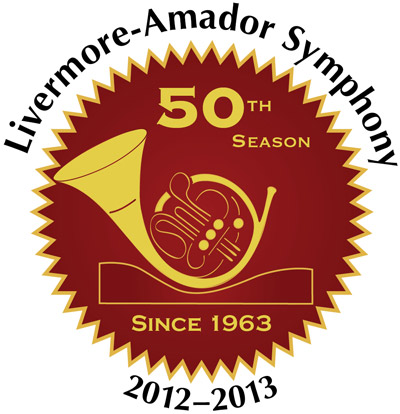 Livermore-Amador Symphony
Livermore-Amador Symphony
May 18, 2013
Ode to a Joyous 50th Season
This concert is sponsored by the Livermore-Amador Symphony Guild.
Doors open at 6:45 p.m.
Prelude talk from 7–7:30 p.m.
Concert begins at 8 p.m.
Bankhead Theater, 2400 First Street, Livermore, California
Beethoven: “Coriolan” Overture
Beethoven: Symphony No. 9
Nancy Wait Kromm, soprano
Wendy Hillhouse, alto
Norman DeVol, tenor
William O’Neill, baritone
Pacific Masterworks Chorus and Valley Concert Chorale
To read the concert program insert, including program notes, click here (942K pdf)
To listen to the Prelude lecture by Peter Curzon, click here (42MB mp3).
 Completing the orchestra’s triumphal Golden Season is a symphonic and choral tour de force: an all-Beethoven program whose capstone is the Ninth, the apotheosis of Beethoven’s symphonies, if not all his music. Often called the “Symphony of Joy”, the moniker endures not just for the supremacy of the famous “Ode to Joy”, but for the sheer force of joy that infuses all the music from beginning to end. The ideas Beethoven would use in his monumental work were in formation for many years: melodies and parts that he would ultimately use in the Ninth date back to the gestative years before he wrote his First. Schiller’s poem “The Ode to Joy” interested Beethoven from 1793, when he sought to place it in song, but the musical theme of the last movement was written only a year before the completion of the symphony, showing that Beethoven composed the work over his entire life. Including a chorus with four soloists, the Ninth is the first symphony by a major composer to use the voice as an instrument. Written after Beethoven’s deafness was complete, it stands as a testament to the composer’s musical genius and is considered by many to be the greatest piece of music ever written.
Completing the orchestra’s triumphal Golden Season is a symphonic and choral tour de force: an all-Beethoven program whose capstone is the Ninth, the apotheosis of Beethoven’s symphonies, if not all his music. Often called the “Symphony of Joy”, the moniker endures not just for the supremacy of the famous “Ode to Joy”, but for the sheer force of joy that infuses all the music from beginning to end. The ideas Beethoven would use in his monumental work were in formation for many years: melodies and parts that he would ultimately use in the Ninth date back to the gestative years before he wrote his First. Schiller’s poem “The Ode to Joy” interested Beethoven from 1793, when he sought to place it in song, but the musical theme of the last movement was written only a year before the completion of the symphony, showing that Beethoven composed the work over his entire life. Including a chorus with four soloists, the Ninth is the first symphony by a major composer to use the voice as an instrument. Written after Beethoven’s deafness was complete, it stands as a testament to the composer’s musical genius and is considered by many to be the greatest piece of music ever written.
© Livermore-Amador Symphony Association